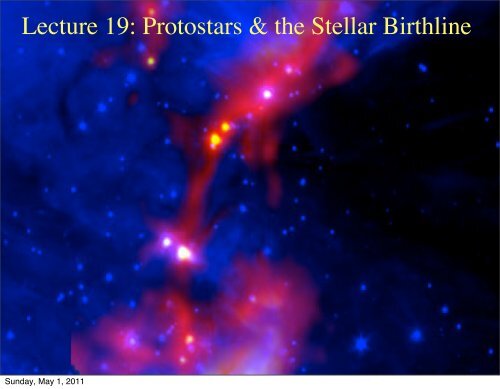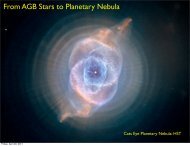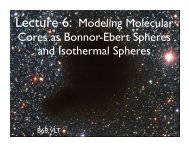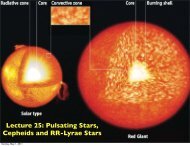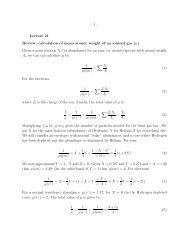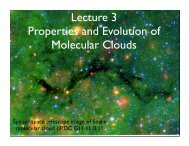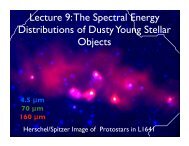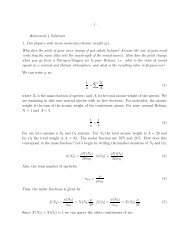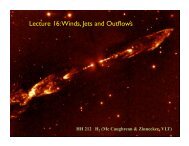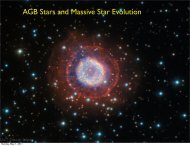The Stellar Birthline
The Stellar Birthline
The Stellar Birthline
You also want an ePaper? Increase the reach of your titles
YUMPU automatically turns print PDFs into web optimized ePapers that Google loves.
Lecture 19: Protostars & the <strong>Stellar</strong> <strong>Birthline</strong><br />
Sunday, May 1, 2011
<strong>The</strong> Road to the Main Sequence<br />
Cloud: complicated balance between gravity, turbulent<br />
motions, and magnetic fields resulting into fragmentation.<br />
Isothermal and optically thin to IR and radio wavelengths.<br />
Increasing Density<br />
Increasing Time<br />
Core: thermal pressure in rough balance with gravity<br />
(may not exist for massive stars). Isothermal and optically<br />
thin to IR and radio wavelengths.<br />
Protostar: an optically thick object in hydrostatic<br />
equilibrium results from the collapse of unstable cores.<br />
Sunday, May 1, 2011
Decreasing Luminosity<br />
Increasing Time<br />
Protostars: Accretes mass throughout protostellar<br />
phase. Can undergo Deuterium fusion (for low mass stars)<br />
and Hydrogen fusion (high mass stars). Accretion onto star<br />
with a disk. Must overcome magnetic pressure, resulting in<br />
magnetospheric accretion for low mass stars. Must overcome<br />
photon pressure for high mass stars.<br />
Pre-Main Sequence Star: only happens<br />
for low to intermediate stars. Star contracts and center<br />
heats up. Deuterium fusion possible.<br />
Main Sequence Stars: hydrogen fusion.<br />
Long period of stable luminosity and radius.<br />
Sunday, May 1, 2011
Review: Convective Pre-Main Sequence Stars<br />
Where for cool stars, the H - opacity gives a = 10<br />
4<br />
Sunday, May 1, 2011
Review: Convective Pre-Main Sequence Stars<br />
5<br />
Sunday, May 1, 2011
Review: Radiative Pre-Main Sequence Stars<br />
In the centers of contracting pre-main sequence stars, as<br />
temperature increases, opacity drops so that radiation can<br />
effectively transport energy.<br />
At this point, you begin to have radiative tracks where the<br />
luminosity increases as the radius of the star shrinks.<br />
6<br />
Sunday, May 1, 2011
Convective (Hayashi) Track<br />
Radiative (Henyey) Track<br />
Increasing Time<br />
Decreasing Radius<br />
Constant Teff (Increasing Tc)<br />
Decreasing Luminosity<br />
Increasing Teff (and Tc)<br />
Increasing Luminosity 7<br />
Sunday, May 1, 2011
Pre-main sequence<br />
tracks: Baraffe et<br />
al. 1998 (from<br />
Winston et al.<br />
2007)<br />
Convective (Hayashi) Tracks<br />
Radiative<br />
(Henyey)<br />
Track<br />
8<br />
Sunday, May 1, 2011
Now go to protostellar phase<br />
9<br />
Sunday, May 1, 2011
<strong>Birthline</strong><br />
<strong>The</strong> <strong>Stellar</strong> <strong>Birthline</strong><br />
<strong>The</strong> <strong>Stellar</strong> <strong>Birthline</strong> is the<br />
initial point for pre-main<br />
sequence contraction. It<br />
comes from a calculation of<br />
the mass and radius of an<br />
accreting protostar with<br />
time. At some mass, the<br />
accretion is terminated, and<br />
pre-main sequence<br />
contraction begins.<br />
pre-main<br />
sequence tracks<br />
Stahler 1983<br />
Stahler 1988<br />
Palla & Stahler 1990<br />
10<br />
Sunday, May 1, 2011
<strong>The</strong> <strong>Stellar</strong> <strong>Birthline</strong><br />
11<br />
Sunday, May 1, 2011
Sunday, May 1, 2011<br />
12
We define α:<br />
13<br />
Sunday, May 1, 2011
Sunday, May 1, 2011<br />
14
Sunday, May 1, 2011<br />
15
Now we can write:<br />
16<br />
Sunday, May 1, 2011
Hartmann et al 1997<br />
<strong>Stellar</strong> <strong>Birthline</strong> for total luminosity L=0 and two different<br />
accretion rates.<br />
Different values of α are used in the left panel.<br />
Sunday, May 1, 2011
<strong>Stellar</strong> birthline for total luminosity L=0<br />
This shows the evolution of central temperature and f, the fraction of<br />
D/H (relative to the interstellar abundance.)<br />
core temperature<br />
Hartmann et al 1997<br />
fraction of Deuterium<br />
Sunday, May 1, 2011
<strong>The</strong> Effect of Surface Cooling<br />
Hartmann et al 1997<br />
Sunday, May 1, 2011
<strong>Stellar</strong> <strong>Birthline</strong>: Palla & Stahler 1993<br />
Large variations in radius may occur to Deuterium burning.<br />
20<br />
This may depend strongly on accretion rate.<br />
Sunday, May 1, 2011
Summary<br />
<strong>The</strong> <strong>Stellar</strong> <strong>Birthline</strong> is the path a protostar takes in Mass vs<br />
Radius space as it creates.<br />
<strong>The</strong> birthline sets the initial conditions of pre-main sequence<br />
contraction.<br />
<strong>The</strong> birthline is strongly dependent on the amount of energy<br />
deposited by the accreting gas, the amount of the star<br />
covered by accreting gas, and energy generation by burning of<br />
Deuterium (next lecture).<br />
<strong>The</strong> birthline may be dependent on accretion rate, and not<br />
the same for every star.<br />
Sunday, May 1, 2011


